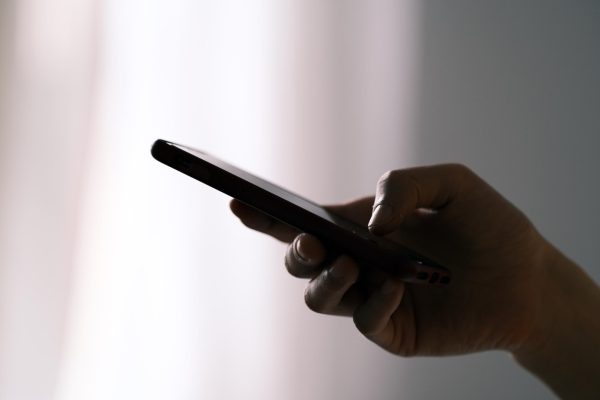A quiet buzz escapes the turned-over phone on my desk. I had been so focused on studying, but… what if it’s urgent?
Then comes the next question: how long do I take to respond? What should I respond with? Depending on the person, it might be a multi-paragraph rant or simply a heart reaction.
In past decades, communication involved people standing at telephone booths or dialing rotary phones. Now, it is centered in one’s hand at all times. A person sends an average of 72 text messages a day, and that number is only increasing. With so many of today’s interactions virtual, an entirely new set of cultural guidelines have formed across a variety of platforms dictating professional and personal discourse.
Technology may be used to avoid a difficult conversation, ignoring a pressing message out of fear of response. More commonly, however, it can prompt one, allowing time for people to process and reflect. This pause enables the possibility of moderating reactions, acting more professionally, and thinking more thoughtfully.
In all cases, response rate determines how those in conversation perceive each other and the importance of their dialogue.
“In the best-case scenario [for face-to-face conversations], fast response times are an indication that people are ‘on the same page’ as each other,” said Dr. Emma Templeton, a postdoctoral fellow at Dartmouth College’s Department of Psychological and Brain Sciences. “It means that they are able to accurately predict what their partner is going to say, anticipate when they are going to stop speaking, and plan a response in advance. It is typically also an indication that someone is excited to build upon what someone was saying.”
Fast responses may reflect enthusiasm and a desire to participate, but they can also signal destructive listening. “There are some instances where fast response times might not be a good thing,” Templeton continued. “For example, in an argument, people might be responding quickly but not actually listening to each other.” Just as with spoken communication, pausing to reflect and slowly read helps strengthen our capacity to listen.
Our responses are also dictated by the strength of the relationship. During the first stages of communication, users typically mimic each other in length of messaging (especially email) and wording. Gradually, responses get shorter and less formal.
Not only do mediums like texting provide ways to speak from miles apart, they help those involved leave their current situations and enter a new, exciting situation. As people exchange information and ideas, stories and anecdotes, the quicker the response, the more connected the group feels.
Dr. William Swann created the Brief Loquaciousness and Interpersonal Responsiveness Test (BLIRT) to gauge how people respond, weighing rapidity of speech. He explained, “For high blirters, there is minimal reasoning behind [their] speedy responses [they speak as soon as they have a thought]. In contrast, low blirters may respond slowly for any of several reasons, including concerns about how they might come across or a desire to say things that will maximize their outcomes.”
Preoccupation with how one’s wording will be received is a common occupier of time, in anything from job interview appreciations to close friends. Concern may also amplify with the permanence of the message, with prominent ideology like “once you say something on the internet, you can’t take it back.” Even with the recently updated “unsend features,” online communication provides a sense of permanence. Though the words disappear, the message remains in the phone and platform database, and, on Instagram, should someone feel the need to report a person’s conversation, this data will include any deleted messages.
With social media so deeply immersed in modern culture, certain norms have formed over time. General online etiquette follows a focus of thoroughness and immediacy. Time-sensitive texts should receive responses immediately, and delay merits an apology — not to justify but to move forward. Respond during working hours (ideally weekday mornings), and avoid taking longer than a day. Do not reply while with other people — this is seen as rude. There is a balance to be maintained — not spamming a group, not taking too long to respond, and being thoughtful and concise.
These social standards inform behavior, allowing communication needs to be met efficiently and effectively. Responses do not need to be long either, with more than half of e-mails containing less than 43 words and the average response only five.
However, specific norms come with age, and reliance on online communication varies by generation. The Silent Generation (1925-45) and Baby Boomers (1946-64) usually emphasize in-person communication, or phone calls as an alternative. They have not grown up with handheld devices, so it stands to reason that a complete shift online might overwhelm them.
Generation X (1965-79) then bridges this divide, preferring email for professional communication and social media for personal use. In their primary working years, online work and collaboration developed to the strength it is at now.

Then, those who have grown up with this technological access know no difference. Millennials (1980-1994) and Generation Z (1995-2012) rely much more on social media, prioritizing texting, direct messaging, and avoiding phone calls at all costs.
As age increases, response time decreases. Most people can expect e-mail responses within an hour, but, according to Forbes, teens may respond in as little as thirteen minutes, followed by younger and then older adults.
Templeton reflected, “Insofar as communication depends on different technologies, there are likely generational gaps as different age cohorts grow up with different methods of communicating. For example, my dad still often signs his name to text messages whereas my sister would never do that.”
“My parents don’t text very often, so I’d say our frequency in texting is a rather big generational divide between us,” said Nehla Chowdhury ’24. “I prefer texting to calling, while they do the opposite. I also tend to use a lot of lingo when I text people, which is another big contrast, as many of the older people in my life don’t tend to do that. Instead, they normally type out the whole word.”
With this change in times comes a larger change in social dynamics. While phone calls can provide auditory nonverbal cues, tone indicators have taken the place of body language, engaging a new audience with ways of clarifying intent online. To make sure the intention of one’s words come across, one might end a sentence with “/gen” to emphasize a genuine response or “/j” for joking. Emojis, too, play a role, providing visual insight to accompany messages otherwise misunderstood in subject or brevity.
Understanding what it means to interact digitally has many elements, but one of particular note is the Coronavirus pandemic, which led to an engaged frequency with online formats and a reduction in meeting time. Reliance on devices increased as a way of sustaining connection when going outside was dangerous, and many of the habits developed in and around 2020 still exist.
Just as with in-person talks, digital communication comes with its own set of cues and interpretations (from punctuation, or lack thereof, to response rate). Respecting someone’s time and energy takes precedence, alongside an acknowledgement of good will. A lack of response more often than not, won’t stem from a deeply rooted hatred; sometimes, an e-mail gets lost in the inbox.
Additionally, as digital citizens, online users of social media, we are privy to a range of topics and discussions. Mindfulness in posting, avoiding oversharing, and maintaining privacy is crucial with online communication. Just because we are not face-to-face does not mean those we communicate with are any less human or deserving of respect.
And, of course, not every conversation is suited for an online format; apologies are typically better in person, as are layoffs (when considering a professional context). Taking breaks from devices reduces multitasking (proven to be an inefficient method of work), improves focus, and allows one to appreciate their relationships with others all the more so.
“It’s important to check in with people to ensure that we are communicating in a way that is promoting [a] feeling of connection,” advised Templeton. As we explore various mediums, we can place a unique focus on being present with our work and loved ones, centering attention over quantity. Authenticity remains more important than ever; without seeing a person face-to-face, knowing who a person “is” brings comfort to an online space.
I abandon the textbook, the phone screen lighting up my face as I open it up. I may be an hour and forty five minutes away from my friends — perils of the New York City MTA — but I have never felt closer.
Not only do mediums like texting provide ways to speak from miles apart, they help those involved leave their current situations and enter a new, exciting situation. As people exchange information and ideas, stories and anecdotes, the quicker the response, the more connected the group feels.

